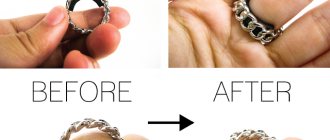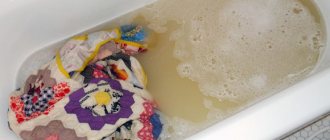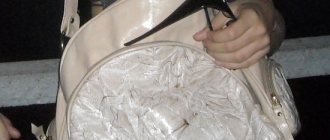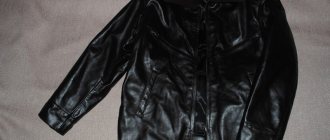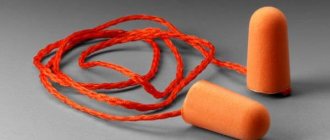Sophia bought a faux fur coat
At the beginning of winter, I pleased myself with a new thing - a white faux fur coat, and on the same day I went for a walk with a friend. A car rushed past and splashed me with mud. I was horrified because I had no idea what faux fur was made of and whether it was possible to wash a faux fur coat.
However, a friend reassured me and offered to figure out how to wash faux fur. I will share the information I found in this article.
It is possible to wash faux fur at home.
Can faux fur be washed?
Faux fur can be washed provided that the relevant information is provided on the tag. The latter also indicates the permitted cleaning method (mechanical or manual). At the same time, regardless of the type of material from which the fur hood or fur coat is made, the following recommendations must be followed when washing:
- The pile can be soaked in water for a long time and dried with cold air.
- Due to prolonged drying near heating devices (radiators, hair dryers, etc.), the fur pile loses its former shine and becomes harder.
- Ironing fur is prohibited. Instead, it is recommended to use a soft sponge or brush designed for this material.
- Faux furs should not be washed at home using aggressive substances or bleaches.
- Wash using liquid soap or gel. Washing powder granules often get tangled between fur fibers.
- It is not recommended to wash faux fur in washing machines or by hand too often. It is better to carry out the procedure as it gets dirty.
- Do not soak fur coats in water at high temperatures.
It is especially difficult to wash a faux fur coat with long white pile. Due to incorrectly selected cleaning products, the material turns yellow and breaks.
Is it possible?
If the faux fur gets dirty, you can wash it. Most products tolerate such treatment well and do not lose their attractiveness.
Conditions to be observed:
- Study the information indicated on the label. The manufacturer's recommendations should not be violated.
- If the fur comes off, it is better to remove it and wash it separately from the main product.
- Before you start washing, the item must be cleaned of dust and other contaminants. To do this, use a low-power vacuum cleaner or a soft-bristled brush.
- Washing fur items together with other items is unacceptable.
- If there are minor stains on the fur, do not wash it completely. Limited to local treatment of stains.
- Preference is given to hand washing.
It is not recommended to machine wash long faux fur, but the shorter it is, the lower the risk of damage. You should not experiment with fur trim of questionable quality.
Then the pile is combed. This will give it freshness after a long stay in the closet.
How to wash in a washing machine
Faux fur requires delicate care. However, some types of this material can be washed mechanically.
Preparing for washing
Before washing a fur coat or other fur clothing, you must:
- remove dust and other contaminants by knocking out or brushing the product;
- clean small stains using suitable products;
- Turn the clothes inside out and fasten all the zippers and buttons;
- if it is necessary to wash the collar, then the latter must be unfastened from the jacket.
It is necessary to wash a faux fur coat separately from other items. If there is a lot of space left in the automatic machine after inserting the product, then it is preferable to choose manual cleaning of clothes.
Before each wash, faux fur must be soaked in warm water with diluted liquid soap for 15–20 minutes. It is recommended to begin cleaning white pile by treating it with a cotton pad (sponge) soaked in lemon juice.
Liquid gels (HELP, Yplon and others) created for cleaning faux fur products are used as laundry detergents.
Which mode to choose
After preparing for washing, faux fur can be placed in the drum, first wrapped in a light (white) pillowcase or placed in a special case. The latter will protect the material from strong friction that occurs with metal walls.
To avoid damage to the product, it is recommended to set the machine to delicate (manual) mode. The maximum temperature should not exceed 30–40 degrees (depending on the characteristics of the specific equipment). After finishing the wash, you need to run the rinse cycle twice without detergent and conditioner.
Spinning is destructive for faux fur. After washing, the product is immediately hung out to dry in a ventilated area. If the material has lost its former shine, then to restore the color of the villi, you can add a small amount of lemon juice or vinegar to the water when rinsing.
Useful tips
Information that a person who decides to wash a faux fur product should have:
- If it is possible to refuse washing, then it should be used. Excessive contact of the product with water will deteriorate its appearance.
- To make the pile smooth, use fabric conditioner.
- When the fur is dry, it needs to be combed. The comb is used with a wide distance between the teeth. You can also use a massage brush. There is no need to push the comb too far into the pile so as not to catch the fabric base.
- If you need to wash a hood or collar with fur, it is better to unfasten it from the main product.
- White fluff is handled with care. Stain removers are not used to eliminate yellowness and grayness.
- The matted pile is sprayed with warm water, allowed to dry, and then combed. You can carefully walk the steamer over the product without pressing the device too tightly against the fabric.
Before using any chemicals that have not previously been used on fur, a test is carried out.
How to wash by hand correctly
To wash a faux fur coat by hand, you need to:
- Fill a basin (for a collar and other detachable fur parts) or a bathtub (for a fur coat) with warm water heated to 30 degrees.
- Dilute a suitable cleaning agent in water. As with the washing machine, when processing by hand, it is recommended to use liquid gels.
- Soak clothes in the prepared solution for 15–20 minutes.
- After soaking is complete, you can wash the item using gentle (massaging) actions. Rubbing faux fur is prohibited, as this will cause the lint to fall out.
- Rinse clothes 3-4 times, changing the water after each procedure. You can hang the fur to dry after all the cleaning agent has been washed out of the material. The first 2 times you should rinse in warm water, then in cold water. This contrast will help restore its original shine.
At the end of hand washing, the collar or fur coat can be squeezed several times to remove excess moisture, or the product can be placed on a horizontal surface and covered with a terry towel.
If you are processing light-colored items, add a small amount of vinegar to the water during the last rinse.
Drying rules
After washing, the fur product must be properly dried so that it does not lose its characteristics:
- Shake the product to remove any remaining water.
- Do not twist or squeeze the item. You can wrap it in a terry towel so that the water is absorbed faster.
- Do not place the product on a radiator or hang it in the sun. Because of this, the fur is deformed.
- During drying, the pile should lie flat, without creases, with the fluffy side up. You can hang the item on hangers without using clothespins.
- You cannot dry your fur with a hairdryer.
Optimal conditions are drying in the fresh air, but in the shade, or in a warm room with good ventilation and low humidity.
Thanks to this simple manipulation, the villi will not bristle when they dry.
What to do if you can’t wash it
If the label indicates that the fur is not washable, you can use the following methods to remove stains:
- Dust and fresh dirt particles are removed using a suitable brush or vacuum cleaner. You can also knock out or shake the product.
- Fresh stains are removed with starch or soda. The bulk substance should be applied to the problem area and left for 15–20 minutes. During this time, starch (soda) absorbs dirt. At the end of the allotted period, the fur coat (collar) is turned inside out and shaken out. To remove residual soda (starch), the fur must be cleaned with a brush.
- Traces of fat and greasy stains are cleaned using a mixture of 1 tsp. alcohol (allowed to replace with gasoline) and 1 tbsp. l. starch. Both substances are mixed to a mushy state. Then the resulting mass is applied to the contaminated areas, left for 10 minutes and combed out with a brush (removed with a cotton swab).
If the described methods do not bring the required result, then the fur product should be dry cleaned.
Dry cleaning at home
If you can’t get the product wet, you can clean it dry. Proven home remedies come to the rescue:
- starch;
- talc;
- semolina;
- soda.
They are used according to the same scheme:
- Spread a clean cloth on the floor or table and place the fur item on it.
- Apply the selected product to the contaminated area.
- Gently distribute it between the pile and knead the fur with your hands.
- Shake the item to remove any remaining powder. You can use a brush, comb or vacuum cleaner with low power.
To get maximum results, the procedure must be repeated several times until the starch or talc becomes completely clean.
To increase cleaning efficiency, cereals or starch can be heated in a dry frying pan or in the microwave.
To clean dark fur, use rye bran or sawdust. Powdered activated carbon removes foreign odors well.
Additional recommendations
The main difficulties with washing arise when it is necessary to clean white fur. In this case, the following methods will help:
- A solution of 9% vinegar (60 ml per liter of water) to remove traces of pickling. The product is applied to the problem area, previously covered with a gauze bandage, and left for 15–20 minutes. After this, the material is wiped with a damp terry towel.
- Freshly squeezed lemon juice with water. Used to remove coffee or tea stains.
- A solution of hydrogen peroxide (20 ml) and water (1 liter). Used to refresh the appearance of the pile.
- A mixture of dishwashing gel, starch and washing powder, taken in equal proportions. The composition is used to remove stains of unknown origin from fur vests or jackets. This mixture must be applied to the contaminated area, wait until it dries completely and remove with a damp cloth.
If after washing the lint begins to come out, this means that the temperature conditions were not maintained or the item was subjected to intense mechanical stress.
How to dry properly
A washed fur jacket or fur coat must first be hung over the bathtub and waited until the water drains, and then in a well-ventilated area or in the fresh air, hidden from direct sunlight. You can also dry such products on a horizontal surface. In this case, the clothes must be straightened, eliminating unevenness (creases), and periodically turned over.
Rules of care
It is recommended to comb fur collars, fur coats and jackets once a week with a metal brush suitable for this material. Thanks to this, the fibers will not roll off. Brushing also removes dirt and dust. Fur coats and jackets should be stored in a special case. In addition, the lining of such clothes cannot be ironed.
It is necessary to wash fur following the manufacturer's recommendations, which are indicated on the label. This material can be processed either manually or in a washing machine. The fur does not tolerate intense mechanical stress and contact with aggressive substances. Also, part of this material cannot be washed.
Traditional methods
In order not to spoil the fur item, people came up with a replacement for water. Instead, you can wash natural fur in rye or oat flour, potato starch, wheat bran, sawdust and many other “detergents”. Each of these methods has its own characteristics:
- Rye or oatmeal flour is poured into a bowl, basin, natural fur is put in there and coated generously, “washing”. After this, you need to shake out the remaining flour, vacuum it if necessary, and then hang it in a well-ventilated place out of the sun. Finally, comb.
- Sprinkle the fur with potato starch. Mix a little shampoo in warm water (you can take animal shampoo), put the resulting solution in a spray bottle and spray it over the starch until it takes on a dough-like appearance. The “dough” is spread and left to dry. Then remove everything with a brush, comb and leave to dry.
- If you are wondering how to wash white fur, you can do this using 5 percent hydrogen peroxide. It will remove yellowness and restore shine. Soak a cotton swab in peroxide and walk in the direction of the pile; if the pile is short, then against it. You can also wrap cotton wool around the teeth of a comb, soak it in peroxide and walk over the product.
- Wheat bran is mixed with a small amount of gasoline and placed in a bowl or basin. Fur is washed by weight: hold the item to be washed in one hand, take the “detergent” with the other and rub it gently into the pile. Next, comb and hang in a ventilated place.
- Hardwood sawdust. They are treated in the same way as with wheat bran. You just need to choose clean sawdust, and in no case from coniferous trees.
- Hot sand. The sand is heating up in the oven. Natural fur is laid out on a flat surface, sand is poured on top and rubbed over the product. If it is not washed, then the dirty sand is replaced by clean sand, and the procedure is repeated.
The fur is damaged after washing, what should I do?
Most likely, the fur coat you washed was unsuccessful. Options for using a damaged item:
- If the appearance remains acceptable, but the fur coat has shrunk several sizes, give it to another person.
- If you are doing needlework or sewing, then the least damaged areas of fur can be cut out and used to sew the intended product.
- If the fur looks unpresentable, then it can be used as bedding for pets.
Fur coats last a long time: from rabbit - 4 years, from arctic fox - 7 years, from mink - 12 years, from beaver or otter - 20 years. Since they cannot be washed, you need to use them correctly:
- Wear a fur coat only in cold weather. Wet snow and rain damage fur.
- If you do get caught in the rain, do not dry the product over a fire or near heating devices, avoid drafts.
- You cannot iron a fur coat even from the lining side!
- Fur deteriorates when exposed to direct sunlight and light. Therefore, store your fur coat in a dark place.
In summer, it is best to store a fur coat in a special refrigerator, where it is dark, the humidity is maintained at about 60%, and the air temperature is within +2-+5 °C. If this service is not available, give the item enough space in your closet so that it does not come into contact with other clothing. Before placing it in the closet, carefully knock the dust out of the fur.
The fur coat should hang on wide hangers, the slope of which corresponds to the angle of the shoulder seams. Be sure to have a special breathable blue cover that will help preserve the color of the fur. There should be a gap between the cover and the coat hanger so that the fur does not get crushed.
«How to wash a fur collar?
“This question is asked by the owners of winter outerwear, which is decorated with this accessory.
A collar is a piece of clothing that began to decorate outfits back in the 13th century. At that time it was a narrow strip in the neckline. The presence of a fur collar on clothing indicated that the owner belonged to some noble family and could afford to hire servants to look after his outfits. Therefore, nobles and grandees wore furs around their necks to show the common people their title and position in society.
An interesting fact in those centuries was that fur collars were usually worn by men. Beautiful ladies acquired this piece of clothing much later, in the 18th century. Since women began wearing collars, their design has completely changed, a huge number of styles have appeared, and they are made from a variety of materials. However, men continued to decorate their outerwear with this accessory. They liked wolf and mink furs, which testified to the masculinity and power of the owner of such an expensive product.
Two centuries later (in the 14th-15th centuries), the fur design was slightly modified into a stand-up collar, which was worn mainly by men. These were cloaks or jackets, they were made of fur and velvet.
An accessory made of fur (especially natural) has always spoken of the status and wealth of the owner, who could afford to wear such an expensive product. Now times have changed a lot; everyone can afford a down jacket with an arctic fox fur collar.
These days, fur collars can be found on many winter jackets and down jackets.
Fur warms the neck and head very well in winter cold and cold. In addition, winter outerwear with edges looks much more impressive. Collars come in two types: with natural and faux fur.
Fur trim is usually sewn with a zipper or rivets so that it can be easily unfastened and, if necessary, easily returned. But there are also such collars, the fur of which is sewn on thoroughly; it can only be unfastened together with the hood. The only way out is to carefully rip off the threads, then wash the jacket and sew the edge back on.
Winter jackets, coats and down jackets need to be looked after regularly; they should be washed when they become dirty.
Over time, dust, dirt and grease stains accumulate on the product. Dust accumulates on a fur collar no less than on the product itself. Therefore, you need to watch not only your coat or jacket, but also your fur collar.
Is it possible to wash a fur collar at all? Of course, it is possible and even necessary. After all, their fur collar, which has not been washed or cleaned for a long time, can cause allergies in people prone to it.
A natural fox collar can be removed from dirt in two ways: dry cleaning and hand washing.
By following all the recommendations, you can easily clean the fur of dirt as delicately as possible.
How to dry natural fur correctly?
If you nevertheless wet cleaned (not washed) products made from, try to dry the product properly. For the hat, prepare a block of wood with a diameter of up to 60 cm. Do not use three-liter jars, as our grandmothers did for drying mink molds. Wood is a hygroscopic material that absorbs excess moisture from the underside of the product.
It is better to dry a fur coat, jacket, sleeveless vest or sheepskin coat made of natural fur on hangers. Try to fasten the item only from the bottom. It is better to leave the top unbuttoned. Leave the product in the air for three hours. After this, turn it inside out and leave for another 2-3 hours. Then hang the item again and leave it until the fur is completely dry. Now comb the fur according to the hair growth using a massage brush.
The same applies to winter ups and downs with weather conditions, when a hat and fur coat can get wet under snow and rain. Observe one condition - do not hang your fur coat to dry next to heating devices.
